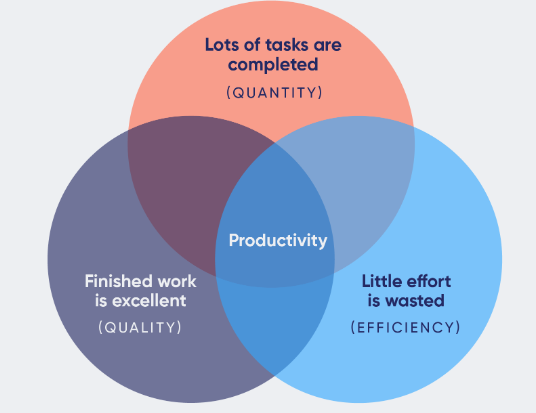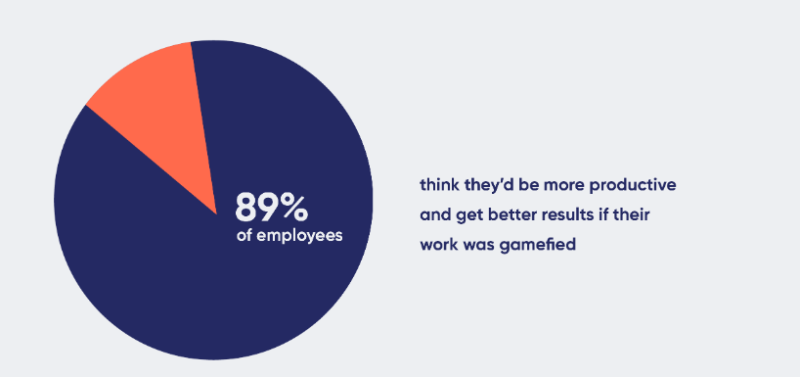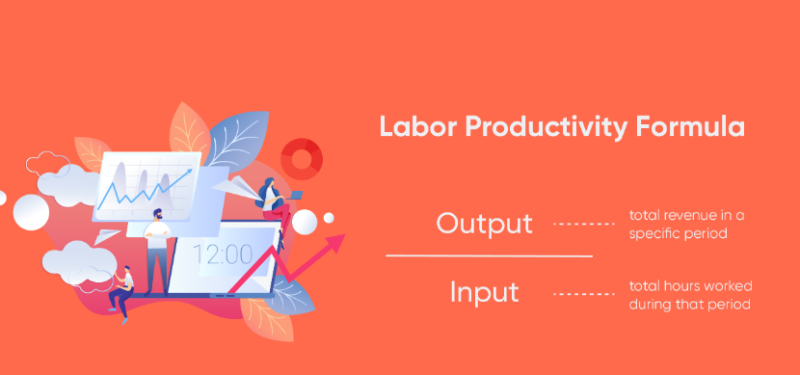

Productivity is a hot topic these days.
For many of us, productivity is an absolute good, an obvious goal for ourselves as much as for the organizations where we work.
It feels like a badge of honor, and our sense of productivity can seem like a direct reflection of our success in life. But, for all that everyone talks about it, we don’t all tend to share an understanding of what productivity means.
The truth is, checking off our to-do list is not what productivity is all about. While personal productivity contributes to business productivity, these two types of productivity are defined very differently.
When you and your boss have different definitions of what’s productive in the workplace, things can get confusing. And unproductive.
In this article, we’ll explore what productivity is and how that definition has changed, how it works for you and your organization, and how to be more productive.
What is productivity?
Politicians, economists, and pundits talk about it at a macro level. Business leaders and managers worry about it in terms of their teams and employees working in a hybrid environment. And most of us, individually, make some assessment as to whether we “felt” very productive on a given day.
Is that all the same thing?
Not quite. Productivity can mean different things in different contexts, especially with the rise of knowledge work and automation. Understanding the different layers of productivity can help you see how your personal productivity at work contributes to your business’s productivity and maybe even how both relate to your country’s productivity.
For countries, productivity measures how well they turn labor and materials (the input) into goods and services (the output, GDP). It’s a broad measure that reflects trends in policy and technology and indicates economic health relative to other things happening in the macro-environment. It isn’t really helpful for thinking about your own productivity.
For businesses, too, productivity measures how well they generate revenue from input, labor and materials. Business productivity usually refers to productivity as revenue divided by hours worked. For company leaders, an aggregate productivity level isn’t likely to provide actionable insights but it can help them see how they compare against competition or other leading firms.
Productivity at the company level — revenue relative to employee labor hours in a quarter — can seem far-removed from our own activities, which might see results or deliver value on a different timeframe.
When people think of “being productive,” they think about what they’re personally getting done. For many people that means checking things off the “to-do” list. That type of personal productivity reflects how efficient you are at completing tasks. But not all the tasks are created equal, and does it matter if they’re done well or just done?

Unfortunately, personal productivity, at work or in life, can be hard to pin down, especially now that many people don’t do repetitive tasks — it was much easier when productivity could be measured by how many widgets a person built per hour.
Personal productivity is a topic of some disagreement in the age of knowledge work. Creativity and innovation, even excellent customer service, doesn’t neatly sum up to an efficiency metric. Nonetheless, it’s useful to think about what productivity means in your role and type of work:
- What is the appropriate way to assess quality or value?
- What is the relevant measure of quantity?
- What are the inputs we want to use most efficiently?
Then try to set the conditions to improve it — whatever the metric:
For your teams and for yourself, the most relevant output to think about is value. Productivity = (value of work) / (employee time, effort).
Value might seem hard to define, but you can start by thinking about outcomes. Something is valuable to you (or to a company) when it helps you achieve your desired outcomes. Not everything on your task list is equivalent in terms of the value it delivers to you or others.
This changes the way we think about productivity to incorporate how effectively an activity delivers value in addition to how efficiently we do that activity. In a company, the value of work is a function of how well the work aligns with the organization’s priorities, the quality it is executed at, and the efficiency with which it is done.
Why is productivity important?
A company can’t be productive without employees being able to effectively and efficiently do the type of work that drives revenue for the company. But while revenue is measured in a current period, value to the company might come from work activities that set the company up to generate revenue in a future quarter, or more likely over many quarters.
Fostering employee productivity that drives business outcomes is an essential part of business success. On the other hand, an employee who feels personally productive often experiences more happiness and fulfillment, too. We all know the let-down feeling of a day when we didn’t feel productive at all despite working at it.
The pandemic transformed productivity for many.
As many of us adjusted to working from home, workers spent 12% less time in large meetings and 9% more time interacting with customers. That helped contribute to a 47% increase in overall productivity across some US companies.
For businesses, productivity signifies the health and growth of the company. A productive business can expand, offering new services and potentially lowering prices.
For employees, productivity is important because it keeps us progressing toward our full potential. Being productive allows us to manage our work, home lives, hobbies, and family commitments with ease and peace of mind.
The benefits of improved productivity
Being more productive is a common goal, but it’s also a goal that many people struggle with.
Only 21% of UK office workers report that they are productive all day, and the average actual productive time in an 8-hour workday is 2 hours and 53 minutes.
Naturally, the challenges employees face with productivity ultimately reflect in the company’s overall output, too.
By being more personally productive, people can complete their work efficiently, tackle errands quicker, and enjoy more free time.
Productivity can help employees enforce healthy work/life boundaries and feel more in control of their circumstances. Some people may even enjoy their work more when they’re productive, and they’re likely to feel less stressed, too.
Traditionally we associate productivity with performance. Each person’s productivity and performance contributes to business success, leading to lower prices, higher profitability, and potentially higher pay for employees.
Companies like NetApp use coaching to improve performance and productivity. When a business has high productivity levels, it uses its resources more efficiently and is poised for growth and expansion.
As business and industry productivity increase, their country’s overall productivity increases, too.
When businesses in a country are producing and providing more goods and services, the country’s economic output is higher than its input. This increases the gross domestic product (GDP), which indicates economic growth. High economic growth leads to a high standard of living, which benefits the whole country.
What are some examples of productivity?
Whether we’re considering personal productivity or business productivity, it always comes down to getting the most output (or benefit) from the input. For businesses, input can mean capital, materials, or labor cost. For people, input usually represents time, effort, and dedication.
Motivating employees is a key part of labor productivity, and being motivated and inspired contributes to your personal productivity.
There are many ways to foster motivation and increase productivity on a personal level and an organizational level.
For personal productivity, there are many techniques that can increase how much you get done in a day without compromising quality. Some popular ones include:
- Breaking large projects into smaller tasks
- Using the Pomodoro Technique (work in short 25-minute intervals)
- Developing a restorative morning routine
- Prioritizing your to-do list to focus on the most important tasks
Businesses can use gamification to motivate employees and increase employee engagement.
When Microsoft added gamification to the sales processes, they saw a 10% productivity increase in contact centers. Plus, 78% of their agents stated they felt empowered and encouraged to perform better at work.

Certain benefits can also increase business productivity. Software company myosh has seen significant productivity gains and cost benefits to maintaining a remote work policy, even before COVID-19.
Understanding what motivates your employees and developing a strong company culture can ultimately drive productivity, performance, and profitability.
How does productivity work?
Most of us understand how personal productivity makes our lives better, but what about corporate or national productivity?
When you’re productive, it takes less time, effort, and mental demand to achieve what you want or create a high-quality finished product.
When the output is the same (achieving what you want), but it takes less input to accomplish it (time, effort, and resources), you are more productive.
It’s the same for businesses.
When businesses produce a larger amount of a given output (goods and services) with less input (labor, capital, and materials), they’re more productive.
Of course, in today’s business, the output for our efforts can be harder to quantify. (That’s why so many people default to a checklist — “done” or “not done” is easy to measure, even if it has no connection to value.) It is hard for individuals or businesses to compare output as value is less and less often delivered as a standard unit of product. However, at the business level, in aggregate, you can compare the level of effort, time, and resources used to produce an equivalent output of sales or revenue.
Businesses measure productivity by taking total revenue (or net sales) in a particular period (the output) and dividing that by the total number of employee labor hours worked in the same period (the input). This is called the labor productivity formula.

Traditionally, higher workforce productivity meant employees are working more efficiently and creating more goods in less time. This leads to increased profits, since companies are spending less on employee payroll expense to generate a number of units of goods or an amount of sales revenue.
Meanwhile, low productivity or partial productivity can indicate issues in the processes used to produce the goods or generate and fulfill the sales.
Even when employee engagement is high, if the production process slows due to a lack of materials or capital, productivity levels will drop. This is because labor cost (or workforce productivity) is only one input that goes into the labor productivity formula.
Governments measure multiple productivity factors to understand the overall economic productivity and recognize productivity trends.
For example, one 2020 productivity trend was working from home, and the economic data shows that GDP could increase if employees continued to work remotely 1-2X a week.
While one productive person makes a difference, national GDP and corporate productivity rely on extensive employee engagement to deliver results.
How can you be more productive?
Now that you see how your personal productivity affects the whole system, you’re likely feeling inspired to become more productive at work. It helps to know that your role makes a difference!
Here are some valuable tips to help you be more productive at work.
Gamify your tasks
Turn checking off your to-do list into a challenge, and get your co-workers involved, too.
89% of employees feel like gamification would make them more productive at work, so increase your productivity level with some healthy competition. Create a productivity group and set prizes for whoever checks the most off their to-do list in a day or week.
Take breaks
While deep work can be powerful, taking breaks ultimately helps us be more productive. Using the Pomodoro technique can remind you to step away from your desk, stretch, and refocus your mind.
Taking a short break refreshes your perspective and helps you discover new ways of solving problems.
Define your goals
Knowing your objectives can help you stay on track and get more done.
Keeping your goals top of mind and creating a short-term to-do list that focuses on an overarching goal can help you stay motivated.
Discover when you’re most productive
Track your daily activity and reflect on how you feel about the quality and value of the output to see when you’re most productive. Don’t stop at just looking at activity tracking as a measure of productivity. These types of productivity tool reports can be a useful starting point and input into how you understand your own productivity.

Maybe you work on creative tasks best in the morning, but you save administrative tasks for the afternoon. Understanding how you work best can help you schedule your day for peak performance.
Communicate with your team
You don’t need to figure everything out on your own. Learn to delegate and collaborate. Ask for help and work together.
When you’re in an efficiency mindset, you might think that doing it yourself is more efficient and productive than taking the time to bring in others. Reaching out to a team member can help you get better answers quickly and ultimately create more value. A quick message or phone call may be all you need to keep moving forward.
Best productivity books
When it comes to improving your personal productivity, these suggestions are just the tip of the iceberg.
If you’re ready to dive in and transform your productivity, check out these three influential productivity books.
Essentialism
If you feel like you’re always busy but still not productive, Essentialism: The Disciplined Pursuit of Less by Greg McKeown is for you.
Essentialism emphasizes pursuing fewer things and doing them very well. Rather than checking off a long to-do list but doing subpar work, Essentialism recommends a minimalist approach to productivity.
Deep Work
If distractions are your downfall, Deep Work: Rules for Focused Success in a Distracted World
by Cal Newport is a must-read.
Deep Work helps you master the art of focus. In Deep Work, you’ll discover how to learn rapidly and apply your knowledge right away, without succumbing to distractions.
Eat That Frog
Prioritizing work can be a challenge. Eat That Frog!: 21 Great Ways to Stop Procrastinating and Get More Done in Less Time by Brian Tracy makes prioritization intuitive and simple.
This book is a powerful tool to help you transform your productivity. In Eat That Frog, you’ll learn how to tackle the toughest task first thing in the morning.
Time to hone your productivity skills
Now that you know how personal productivity fits into corporate productivity, you’re ready to boost your productivity skills!
Your newfound productivity abilities can make every area of your life easier to manage, too.









You must be logged in to post a comment Login